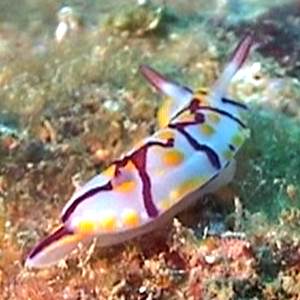
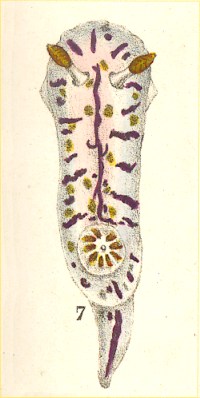
Hypselodoris zebrina
(Alder & Hancock, 1864)
Order: NUDIBRANCHIA
Suborder: DORIDINA
Superfamily: EUDORIDOIDEA
Family: Chromodorididae
PHOTO
Taplamu, Thailand. Depth between 12m to 20m. Photo: Danny Van Belle
Lower: Chromodoris zebrina, Madras region, southeastern India. Original painting - Alder & Hancock, 1864: Plate 29, fig 7.
I am sure this is Hypselodoris zebrina, a species which was described about 150 years ago from southeastern India and has never been reported since. I have scanned a copy of the original illustration alongside for comparison (Alder & Hancock, 1864: Plate 29, fig 7).
Here is an extract from the original description describing the colour pattern:
"white with waved crimson stripe down the centre of the back and transverse stripes of the same colour (of unequal lengths) at the sides and around the ends; there are largish yellow spots down each side of the central stripe and between the transverse ones near the margin; a crimson stripe also runs from the cloak along a ridge to the tail. Dorsal tentacles .. with laminated part crimson ... [Gills] simply pinnate, crimson ... Length 2/10 inch" [p123-4].
In the original description, the colour of the stripes and the gills and rhinophores are described as 'crimson' but the illustration would suggest 'purple' may have been a better word to use. Priscilla Yeo's photo, and subsequent photos from Danny Van Belle show the colour variation in this species, in particular the variable nature of the purple median line on the mantle, ranging from a continuous line, to a few spots, and sometimes absent. The yellow spots, radial purple lines, and purple dorso-median line down the posterior foot are all very characteristic features found in no other species of chromodorid.
It has similarities to Hypselodoris kanga, Hypselodoris nigrostriata and Hypselodoris zephyra all with yellow spots, and bluish purple lines, but in those species the gills are triangular in cross-section, while in your animal they are simple. The species was originally placed in the genus Chromodoris. Although no anatomical information is available the general body shape and colour pattern would suggest that it is most likely to be a species of Hypselodoris.
Reference:
• Alder, J. & Hancock, A. (1864) Notice of a collection of nudibranchiate mollusca made in India by Walter Elliot Esq., with descriptions of several new genera and species. Transactions of the Zoological Society of London, 5: 113-147.
Rudman, W.B., 2002 (December 10) Hypselodoris zebrina (Alder & Hancock, 1864). [In] Sea Slug Forum. Australian Museum, Sydney. Available from http://www.seaslugforum.net/find/hypszebri
Related messages
Re: Hypselodoris zebrina - unseen for 150 years
September 1, 2009
From: Shinya Shigemi
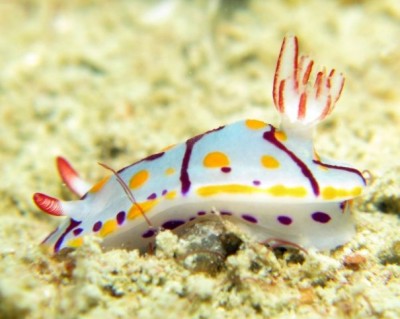
Concerning message #8590:
I found the nudy at Pulau Payar in Malaysia. Pulau Payar is located in Andaman Sea and I often go there to dive.
Locality: Pulau Payar, 20 m, Penang, Malaysia, Andaman Sea, 04 July 2009, Dredged. Length: 20 mm. Photographer: Shinya Shigemi.
Please see the attached photos.
I think that this nudy is Hypselodoris zebrina.
Am I right ?
Regards,
Shinya
kanikingyo@yahoo.co.jp
Shigemi, S., 2009 (Sep 1) Re: Hypselodoris zebrina - unseen for 150 years. [Message in] Sea Slug Forum. Australian Museum, Sydney. Available from http://www.seaslugforum.net/find/22576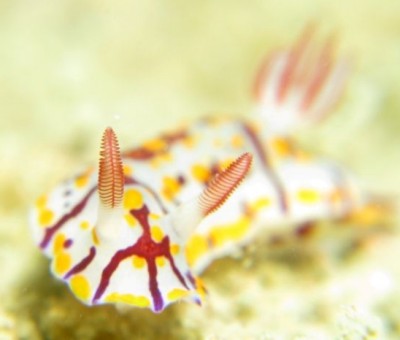
Thanks Shinya,
This is certainly what I have identified as Hypselodoris zebrina. It's good to get another record of this 'long lost' species.
Best wishes,
Bill Rudman
Re: Hypselodoris zebrina in aquarium
May 8, 2003
From: Kara
Ok, now I definitely know what this beautiful little creature is and its mystery .. I'm worried that I can't provide the fodder it needs to live long term. I talked to the guys at the LFS and they said the shipments of soft corals that came in were from Indonesia. Not a whole lot of help, but that's all they knew. If there is anyone else out there that can provide sponges from it's region for it to eat, I will gladly ship the nudibranch to you. I don't want it to die from starvation and I'm sure there are people out there better equiped to feed the little guy than I am.
Kara
kara@karaquarium.com
Dear Kara,
In your first message you seemed to think it had grown in your tank. If so, then it must have found something to its liking in your aquarium. They are very specific feeders so the chance of it finding the right sponge in another aquarium is pretty slim. My advice would be to keep it and just hope it's food supply holds out.
Cheers,
Bill Rudman
Hypselodoris zebrina in aquarium
May 1, 2003
From: Kara
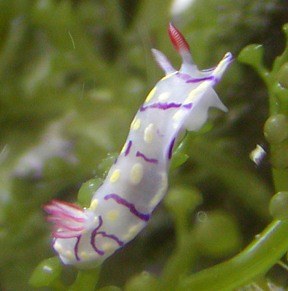
I got it from a LFS for free because they thought it might eat soft corals. They believe it came in with a shipment of corallimorphs. I put it in the tank with Roy, my mantis shrimp and tossed in some excess Xenia. The nudibranch has been doing really well, doubled in size (from 1/4" to 1/2") in the past month or two, so it's eating something but the Xenia hasn't been touched. Roy likes to look at the nudibranch but won't touch it.
After searching through the site, I thought it might be Hypselodoris zebrina I'm hoping to get some info on what types of foods I should be providing it.
Thank you for your help! I really love this little nudibranch and hope I can keep him happy and healthy!
Kara
kara@karaquarium.com
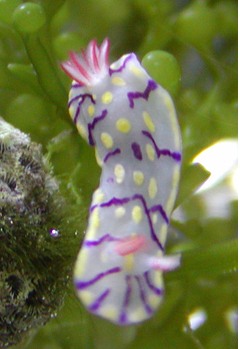
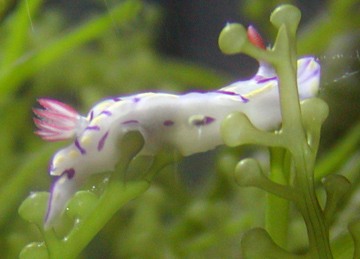
Dear Kara,
This is almost certainly Hypselodoris zebrina. I would certainly be interested to know where your LFS got its shipment from for as far as I can tell the other records on the Forum are the only records of this animal being found in almost 150 years. I am sure it is a sponge feeder, so if it is growing then you must have a sponge colony in your aquarium that it is partial to. It is certainly leading a lucky life, not only has it avoided being eaten by Roy, but you apprently have its preferred sponge. If you can find what its eating and take a photo of it, it will be an exciting NEW bit of biological information about this animal
Good Luck
Bill Rudman
More photos of Hypselodoris zebrina
December 18, 2002
From: Danny Van Belle

Hi Bill,
I hope this will be useful !!! I think I have some pics of Hypselodoris zebrina or Hypselodoris kanga or Hypselodoris infucata!!! Which one is what?
All filmed at Boonsung wreck, Taplamu, Thailand. Depth between 12m to 20m.
They are quite common on this divesite "the Boonsung Wreck" but only on this site and nowhere else !!! I've made about 1500 dives in the area of the Andaman Sea - Thailand.
Best regards
Danny
dannyvb@hotmail.com
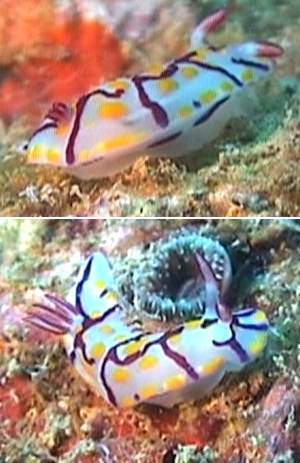
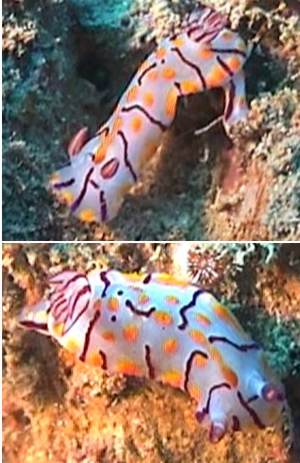
Thanks Danny,
Your photos are an excellent addition to Priscilla's photo and certainly confirm in my mind that this species is Alder & Hancock's H. zebrina. The absence of a purple median line in Priscilla's photo was a major difference from the original painting, but your photos show that the line can be present or absent. This is a very valuable contribution.
Best wishes,
Bill Rudman
Re: Hypselodoris zebrina
December 17, 2002
From: Priscilla Yeo
Dear Bill,
I would really like to thank you for all your efforts in trying to identify this little creature for me! you have no idea how happy i am to have this mystery cleared up! i have made arrangements to go up again to the original site during the christmas week, and i hope to find this nudi again, and hopefully take much better shots this time... who knows.. maybe i might be able to find another lost specimen...?!!
cheers
Priscilla
prisla@singnet.com.sg
Yeo, P., 2002 (Dec 17) Re: Hypselodoris zebrina. [Message in] Sea Slug Forum. Australian Museum, Sydney. Available from http://www.seaslugforum.net/find/8682Good Luck Priscilla,
Bill Rudman
Hypselodoris zebrina - unseen for 150 years
December 12, 2002
From: Priscilla Yeo
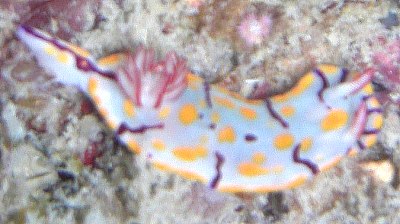
I have just observed this special little creature in dive trip to Trang, in southeastern Thailand, and have inquired to several sources to its exact species and classification to no avail.
This nudi was observed at Ko Waeng, at 9-14 meters and just under a coral outcrop. It was approx. 2-2.5 inches long. I apologize for the quality of the pic, as it was just the tailend of the rainy season in Thailand, and we were about to surface soon. The water conditions were exactly ideal either, and the DM motioned for us to surface REAL soon.
I hope that you would be able to identify this. This is the first time that I have seen this little critter, and since it's the first time that I have dived in Thailand as well, I am probably not too suprised either.
Cheers,
Priscilla
prisla@singnet.com.sg
Yeo, P., 2002 (Dec 12) Hypselodoris zebrina - unseen for 150 years. [Message in] Sea Slug Forum. Australian Museum, Sydney. Available from http://www.seaslugforum.net/find/8590
Dear Priscilla,
This is an interesting find. I am sure it is Hypselodoris zebrina, a species which was described about 150 years ago from southeastern India and has never been reported since. I have scanned a copy of the original illustration alongside for comparison (Alder & Hancock, 1864: Plate 29, fig 7).
In the original description the colour of the stripes and the gills and rhinophores are described as 'crimson' but the illustration would suggest 'purple' may have been a better word to use. In your photo, the inner end of at least one of the purple lines is reddish. This shift from red to purple is not unusual in chromodorids, and would fit the juvenile nature of Alder & Hancock's small animal ('2 tenths of an inch long'). The yellow spots, radial purple lines, and purple dorso-median line down the posterior foot are all very characteristic features found in no other species of chromodorid.
It has similarities to Hypselodoris kanga, Hypselodoris nigrostriata and Hypselodoris zephyra all with yellow spots, and bluish purple lines, but in those species the gills are triangular in cross-section, while in your animal they are simple.
I am very glad you sent this photo even though it is not a perfect shot. It is an extremely valuable observation. I hope this will be a lesson for others who have less than perfect shots. This is primarily a slug site not a photo gallery so a less than perfect shot of an interesting animal or interesting behaviour is just as welcome as a perfect shot of a more common species.
Best wishes,
Bill Rudman
